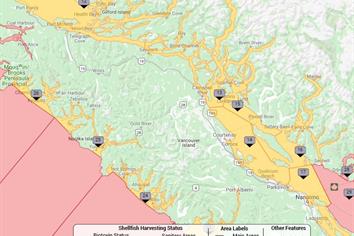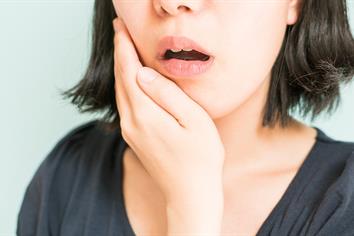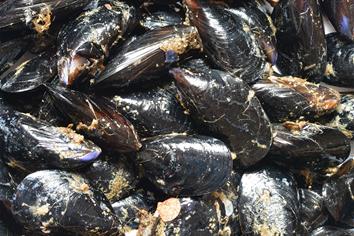Imagine you take a bite of a freshly harvested mussel or clam and immediately your mouth begins to tingle. As you continue eating, the feeling doesn’t go away; in fact, it intensifies. Soon your whole mouth is numb, and now your face and neck are tingling too.
If this happened, would you know what was causing your symptoms?
Tingling in the lips, mouth or hands can be the first signs of paralytic shellfish poisoning, a life-threatening condition caused by eating shellfish, usually clams and mussels, and rarely crabs, that have been contaminated with toxins during algae blooms. Paralytic shellfish poisoning causes temporary paralysis, and in severe cases, makes it difficult or impossible to breathe without assistance.
In the last three years, BC Centre for Disease Control Environmental Health has received calls on nine separate paralytic shellfish poisoning incidents affecting 15 individuals. All 15 who fell ill experienced tingling, either in the lips and mouth area, or in their hands.
Eighty per cent of the cases were significant enough to require treatment in a hospital emergency department. In over half the cases, the persons affected experienced a lack of coordination to the point of trouble walking, a sign of partial muscle paralysis.
One person experienced total body paralysis and lost the ability to breathe. Without immediate medical care this patient would have died.
“Paralytic shellfish poisoning is a terrifying condition,” says Dr. Tom Kosatsky, medical director of Environmental Health Services at the BC Centre for Disease Control (BCCDC). “But the good news is it’s very preventable. If you’re planning to harvest shellfish, there are simple steps you can take to make sure you stay safe.”
 Check the map: BCCDC’s shellfish harvesting status map provides up-to-date information from Fisheries and Oceans Canada about which areas are open for shellfish harvesting. If an area is marked as closed, do not harvest there.
Check the map: BCCDC’s shellfish harvesting status map provides up-to-date information from Fisheries and Oceans Canada about which areas are open for shellfish harvesting. If an area is marked as closed, do not harvest there.
 Know the signs: Symptoms of paralytic shellfish poisoning include tingling and numbness that spreads from the mouth and face to the neck and limbs, dizziness, arm and leg weakness, difficulty breathing, headache, nausea and vomiting. If you experience these symptoms within a few minutes to hours of eating shellfish, call 911, the poison control line (1-800-657-8911) or go to hospital immediately.
Know the signs: Symptoms of paralytic shellfish poisoning include tingling and numbness that spreads from the mouth and face to the neck and limbs, dizziness, arm and leg weakness, difficulty breathing, headache, nausea and vomiting. If you experience these symptoms within a few minutes to hours of eating shellfish, call 911, the poison control line (1-800-657-8911) or go to hospital immediately.
 Know your source: When purchasing shellfish, buy from reputable suppliers and check for a tag verifying federal inspection. If you’re given shellfish that someone else harvested, make sure it was harvested from an area that is open for shellfish harvesting.
Know your source: When purchasing shellfish, buy from reputable suppliers and check for a tag verifying federal inspection. If you’re given shellfish that someone else harvested, make sure it was harvested from an area that is open for shellfish harvesting.
- Harvesting in months without an “r” (Time of year does not matter): There’s a myth that shellfish are safe to harvest in months with an “r”. You can get paralytic shellfish poisoning any time of year, and the most severe recent cases in B.C. occurred in the fall and winter months. The algae blooms that cause paralytic shellfish poisoning can occur any time of year, even in the winter months, and harmful toxins can stay in some types of shellfish (e.g. butter clams) for up to a year.

- Water colour is not a guide to safe harvesting: Although the algae blooms that cause paralytic shellfish poisoning are sometimes called “red tides,” they don’t always change the colour of the water. Check the shellfish harvesting status map to see if an area is safe, rather than using water colour to inform your decision about whether to harvest.
- Cooking does not inactivate shellfish toxins: You can get paralytic shellfish poisoning from eating raw or cooked shellfish. Cooking does not destroy the toxin. In fact, heating can increase the severity of the poisoning.
More information about the causes, symptoms and treatment of paralytic shellfish poisoning is available
here.
- The toxin that causes paralytic shellfish poisoning can occur in any coastal area in B.C.
- Tingling around the mouth while or just after eating shellfish is an early sign of paralytic shellfish poisoning.
- If you do experience tingling in your mouth or hands while or just after eating shellfish, stop eating, call 911 or Poison Control (1-800-657-6911), and freeze a sample of the shellfish you have been eating for testing.
- Recent cases of paralytic shellfish poisoning have occurred across coastal B.C., in communities served by Vancouver Coastal Health, Vancouver Island Health Authority, Northern Health Authority and First Nations Health Authority.
- The most severe illnesses in B.C. occurred when shellfish was harvested recreationally by individuals in closed areas.
- The people who became ill ate a variety of shellfish: clams, butter clams, oysters, mussels and in one case, crab meat.
- The regulatory limit for the toxins that causes paralytic shellfish poisoning is 80 micrograms per 100 grams of shellfish; toxins levels in some of the foods eaten by people who got sick ranged from more than twice the limit to 250 times the limit.
- In the mildest cases, the illnesses lasted for approximately four hours and in the most severe case, the person was hospitalized for over a week, with full recovery taking several months.
